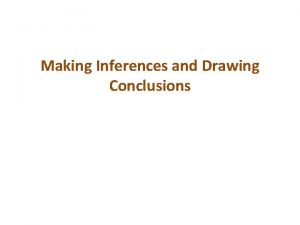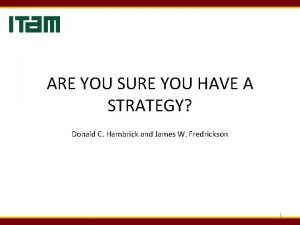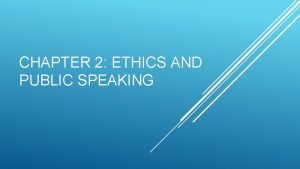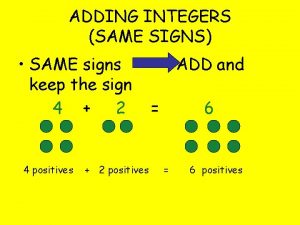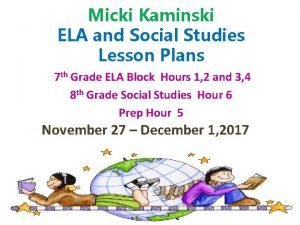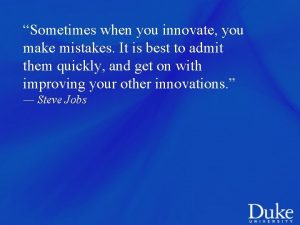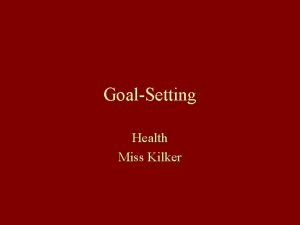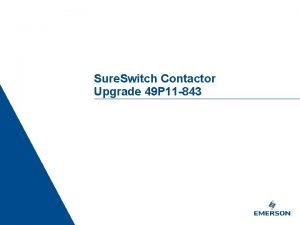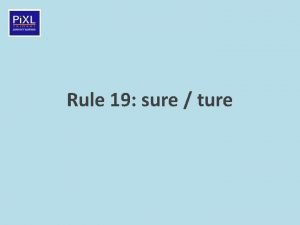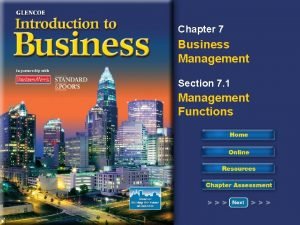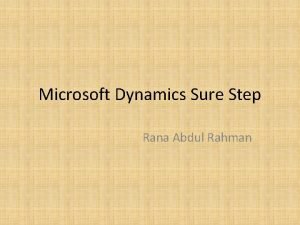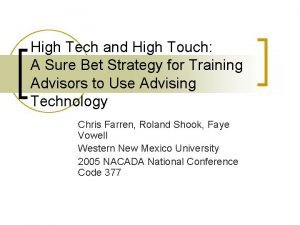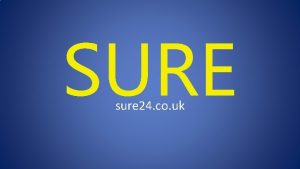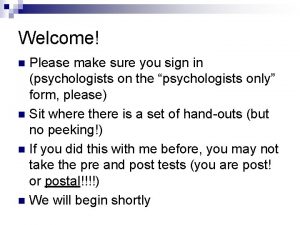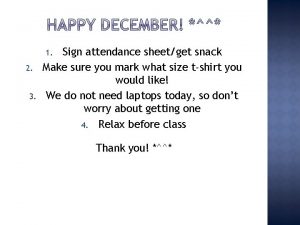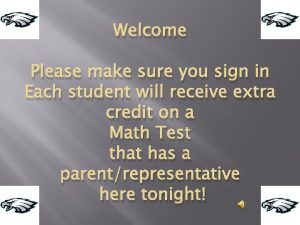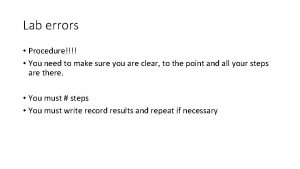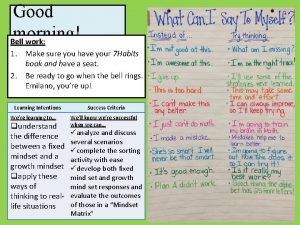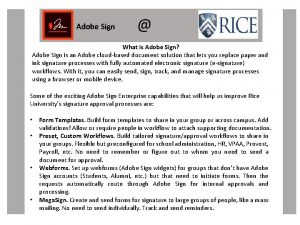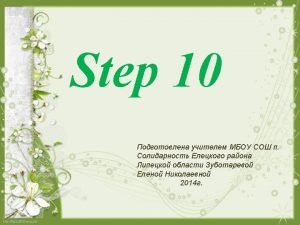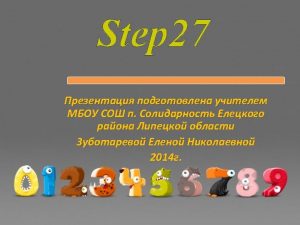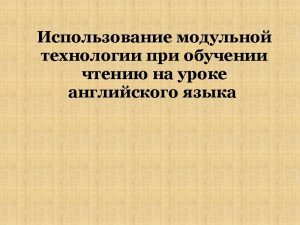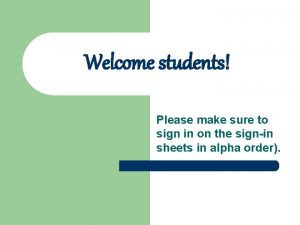MORNING PROCEDURE Make sure you sign inthis takes















































- Slides: 47

MORNING PROCEDURE • Make sure you sign in---this takes the place of roll call and make your name card (color sentence strip) • Grab breakfast items and a drink • Have your materials ready • Complete your Bell Ringer /“DO Now Activity”: Think about your all time favorite teacher. List five special qualities they possessed. (White paper, 8 ½ X 11)) • Be ready to share at the assigned time. Anchor Activity: (for early finishers) Draw a picture of your favorite vacation.

INTRODUCTIONS Myssi Turner • • • • Teaching and Learning Leader Rank 1 16 years of experience Educator: preschool, 2 nd, 3 rd, 4 th, 5 th Staff Developer: K, 1, 2, 3, 4, 5– modeled lessons in all grades Golden Apple Recipient Outstanding Teacher of the Year Recipient Albright Nominee KTIP Resource Teacher SBDM Member of numerous Education Organizations and panels Featured in Ky Teacher and various newspaper articles and on KDE channel PDs at school, district, and state level Julie Kuhnhein • • • Teaching and Learning Leader Masters + 11 years of experience Educator: 9 -12 th, Social Studies Staff Developer: 9 -12, Social Studies American Civic Education Teacher Award UK Teacher Who Made A Difference Award Who’s Who Program Coordinator for Office of Civic Education & Engagement; U of L, College of Ed. • Featured in Ky Teacher and various newspaper articles and on KDE channel • PDs at school, district, and state level When we want your attention, we will use the following signal: Our hand will be raised in the air. When our hand is in the air, you will be expected to have your eyes on the speaker, be quiet, be still, hands free, with one hand in the air and listen.

FRAMEWORK FOR TEACHING CAMPBELL COUNTY SCHOOLS

FRAMEWORK FOR TEACHING CAMPBELL COUNTY SCHOOLS Charlotte Danielson

WHAT IS C. H. A. M. PS? ? • CHAMPs is a decision-making template to assist educators in developing a classroom management plan and implementing it successfully. • CHAMPs provides a common vocabulary for all to use in the promotion of a positive, learning centered culture.

CHAMPS CLASSROOM ACTIVITY Conversation Can students engage in conversation with each other during this activity? If yes, about what? With whom? How many students can be involved in a single conversation? How long can the conversation last? Help How do students get questions answered? How do they get your attention? If they have to wait, what should they do while they wait? Activity What is the expected end product of this activity? Movement Can students get out of their seats? If yes, acceptable reasons include: pencil, restroom, materials, other; Do they need permission to get up? Participation What behaviors show that students are participating fully and responsibly? What behaviors show that a student is not participating?

LEARNING TARGETS I can… • explain the importance of teacher effectiveness on student achievement. • describe how the framework is organized and what tools are available to assist me with its implementation. • use the framework to analyze my own teaching and develop strategies to enhance my practices.

WHY TPGES? Teachers matter more to student achievement than any other aspect of school. • In Texas, the increase student test scores can be traced to a teacher’s effectiveness and it is 20 times more likely to improve student achievement than any other variable. • In North Carolina a strong teacher in a classroom has 14 times the impact on student achievement as decreasing the class size by five students. • MET study has worked within districts across the nation to identify effective teaching. • A growing body of research shows that student achievement is more heavily influenced by teacher quality than by students’ race, class, prior academic record, or school a student attends.

TWO PURPOSES OF EVALUATION Measurement OR Development

FRAMEWORK FOR TEACHING Domain 2: The Classroom Environment Domain 1: Planning and Preparation • Creating an Environment of Respect • Demonstrating Knowledge of Content PLAN and Rapport and Pedagogy • Establishing a Culture for Learning • Demonstrating Knowledge of Students • Managing Classroom Procedures • Setting Instructional Outcomes • Managing Student Behavior • Demonstrating Knowledge of Resources • Organizing Physical Space • Designing Coherent Instruction • Designing Student Assessments APPLY TEACH Domain 4: Professional Responsibilities Domain 3: Instruction • Reflecting on Teaching • Communicating with Students • Maintaining Accurate Records • Using Questioning and Discussion • Communicating with Families Techniques • Participating in a Professional • Engaging Students in Learning Community • Using Assessment in Instruction REFLECT • Growing and Developing Professionally • Demonstrating Flexibility and • Showing Professionalism Responsiveness

COMMON LANGUAGE

PERFORMANCE LEVELS: KEY WORDS Teacher-directed success! Student-directed success! Ineffective Developing Accomplished Exemplary Unsafe Lack of Unaware Harmful Unclear Poor Unsuitable None Partial Generally Inconsistently Attempts Awareness Moderate Minimal Some Consistent Frequent Successful Appropriate Clear Positive Smooth Most Seamless Solid Subtle Skillful Preventative Leadership STUDENTS Always Levels of cognition and constructivist learning increase

THE CLASSROOM ENVIRONMENT DOMAIN #2

FOUR CORNERS/CHIP’S STRATEGY How it works: DOMAIN 2 1. You were already assigned to a group (this will be shared shortly). You will move to the table with your corresponding letter. Everyone will take their materials with them. 2. Introduce yourself to your new group and discuss the teacher qualities that you listed. 3. Read the Framework component that corresponds to your table letter. Each person will need to add to the discussion using their two chips. After you have discussed the component, you will teach the rest of the room about it with a picture representation on your poster and what the important indicators of your component are. Be ready to present your picture and domain component. 4. As people present take notes. 5. While you view examples jot down strategies.

DOMAIN #2 A - ACCOMPLISHED EXAMPLES 2 A – Creating an Environment of Respect and Rapport • Talk between teacher and students and among students is uniformly respectful. • Teacher responds to disrespectful behavior among students. • Teacher makes superficial connections with individual students. Positive Framing, Clip 19 Teachscape Clip • Teacher greets students by name as they enter the class or during the lesson. • The teacher gets on the same level with students, kneeling, for example, beside a student working at a desk. • Students attend fully to what the teacher is saying. • Students wait for classmates to finish speaking before beginning to talk. • Students applaud politely following a classmate's presentation to the class. • Students help each other and accept help from each other. • Teacher and students use courtesies such as "please, " "thank you, " "excuse me. " • Teacher says, "Don't talk that way to your classmates, " and the insults stop.

TEACHER’S CREED My Promises to You, My Students: I promise to be nice and smile often. I promise to care about each of you. I promise to be understanding. I promise to help you when you are struggling. I promise to be patient with you. I promise to be fair and consistent. I promise to enjoy teaching you. I promise to be trustworthy. I promise never to scream at you. I promise that I will get to know you. I promise to believe in you. I promise to make learning interesting and meaningful. I promise that I will not intentionally embarrass you. I promise that I will challenge you to be your very best. I promise to do everything I can to help you succeed. And I promise that, no matter what, I will never give up on you. From Seven Simple Secrets: What the BEST Teachers Know and Do

2 A RESPECT AND RAPPORT Compete Only Against Yourself There is only one person in the world you need to compete against, and that is yourself. Strive each day to be the best person possible. Your mission in life is not to get ahead of other people; your mission is to get ahead of yourself. But while you are competing against yourself, you are expected to work with everyone else in this classroom cooperatively and respectfully. You are responsible not only for your own learning but for the learning of your group-mates as well.

DOMAIN #2 B - ACCOMPLISHED 2 B – Establishing a Culture for Learning • The teacher communicates the importance of learning and the assurance that with hard work all students can be successful in it. • The teacher demonstrates a high regard for student abilities. • Teacher conveys an expectation of high levels of student effort. • Students expend good effort to complete work of high quality. Right is Right, clip 4 TLC Teachscape Secondary A; Elem. B EXAMPLES • Teacher says, “This is important: you’ll need to speak grammatical English when you apply for a job. ” • Teacher says, “This idea is really important! It’s central to our understanding of history. ” • Teacher says, “Let’s work on this together; it’s hard, but you all will be able to do it well. ” • Teacher hands a paper back to a student, saying, “I know you can do a better job on this. ” The student accepts the comment without complaint. • Students get down to work right away when an assignment is given or after entering the room.

DOMAIN #2 C - ACCOMPLISHED 2 C – Managing Classroom Procedures • The students are productively engaged during small-group work. • Transitions between large- and smallgroup activities are smooth. • Routines for distribution and collections of materials and supplies work efficiently. • Classroom routines function smoothly. Teachscape Sec. A; Elem. B Clip 13; Tight Transitions Clip 21; TLC EXAMPLES • Students get started on an activity while the teacher takes attendance. • Students move smoothly between large-and smallgroup activities. • The teacher has an established timing device, such as counting down to signal students to return to their desks. • Teacher has an established attention signal, such as raising a hand, or dimming the lights. • One member of each small group collects materials for the table. • There is an established color-coded system indicating where materials should be stored. • In small-group work, students have established roles, they listen to one another summarize different vies, etc. Cleanup at the end of a lesson is fast and efficient.

WHY PROCEDURES ARE IMPORTANT Students must know from the very beginning how they are expected to behave and work in a classroom work environment. Discipline dictates how they are to behave, and procedures and routines dictate how they are to work. Procedures and routines, especially, offer security. Students want instruction and guidance on all the how-to’s in class. Since a PROCEDURE explains how you want something done, it is your responsibility to have procedures clearly stated. A ROUTINE is what the student does automatically, without prompting or supervision. Thus a routine becomes a habit, practice, or custom for the student.

GIVE ME FIVE! 1. Eyes on speaker 2. Quiet 3. Be still 4. Hands free (put things down) 5. Listen


The goal of positive behavior support is not “perfect” children. Rather, the goal should be the perfect environment for enhancing their growth. -John Marzano




WHY SHOULD WE HAVE PROCEDURES IN OUR CLASSROOM?

PROCEDURES ARE A PART OF LIFE. THEY ALLOW COMPLEX OPERATIONS TO RUN SMOOTHLY WITH MINIMAL CONFUSION, LOW STRESS, AND LESS WASTED TIME. Airports Driving Restaurants Movies School Where else are procedures practiced?

CLASSROOM AND ACADEMIC EXPECTATIONS

CLASSROOM EXPECTATIONS The atmosphere in this classroom will be formal and academic, but comfortable. Students will work hard, learn biology, and enjoy the process. If a visitor walked into our classroom during the day, what should they see?

ENTERING THE CLASSROOM PROCEDURE 1. 2. 3. 4. Enter the room quickly and quietly. Pick up handouts on the bellwork table. Get materials and be seated. Read the bellwork assignment posted on the board and start working. 5. If you finish the bellwork assignment early, work on something else quietly. 6. Quietly, patiently wait for instruction.

BELLWORK PROCEDURE 1. Pick up handouts, be seated, and gather materials for class. 2. Read the bellwork assignment on the board and start working. 3. Do not wait for the teacher or the bell. 4. If you finish the bellwork assignment early, find something quiet to work on while others are finishing.

WHEN YOU FINISH WORK EARLY. . . quietly read a book. organize your planner or homework. use your hand held computer for academic work. sit quietly. do a puzzle. work on homework. wait patiently.

CLASS OPENING PROCEDURES I. Bellwork assignment time A. Students work on bellwork B. Teacher takes attendance, returns papers and checks on individual students as needed. II. After the bellwork assignment A. Teacher announces daily/weekly agenda. B. Teacher discusses returned papers/feedback. C. Bellwork follow up. D. Daily lesson begins.

TARDY PROCEDURE (1) Enter the classroom quietly, pick up the daily handouts, and join in the classroom activities with minimal disruption. You must fill out a pink “tardy form” explaining the reason for the tardy. The teacher will provide the form and you will turn it in by the end of the class period.

TARDY PROCEDURE (2) If you accumulate 3 tardy forms or more in one grading period, you will have a consequence (detention with teacher and/or a phone call to parents). If you accumulate 4 tardy forms or more in one grading period, an office referral will be written with the tardy forms attached. If you are more than 10 minutes late to class (unexcused), it will be counted as an unexcused absence.

BELLWORK PROCEDURE 1. Pick up handouts, be seated, and gather materials for class. 2. Read the bellwork assignment on the board and start working. 3. Do not wait for the teacher or the bell. 4. If you finish the bellwork assignment early, find something quiet to work on while others are finishing.

WHEN YOU FINISH WORK EARLY. . . quietly read a book. organize your planner or homework. use your hand held computer for academic work. sit quietly. do a puzzle. work on homework. wait patiently.

CLASS OPENING PROCEDURES I. Bellwork assignment time A. Students work on bellwork B. Teacher takes attendance, returns papers and checks on individual students as needed. II. After the bellwork assignment A. Teacher announces daily/weekly agenda. B. Teacher discusses returned papers/feedback. C. Bellwork follow up. D. Daily lesson begins.

TARDY PROCEDURE (1) Enter the classroom quietly, pick up the daily handouts, and join in the classroom activities with minimal disruption. You must fill out a pink “tardy form” explaining the reason for the tardy. The teacher will provide the form and you will turn it in by the end of the class period.

TARDY PROCEDURE (2) If you accumulate 3 tardy forms or more in one grading period, you will have a consequence (detention with teacher and/or a phone call to parents). If you accumulate 4 tardy forms or more in one grading period, an office referral will be written with the tardy forms attached. If you are more than 10 minutes late to class (unexcused), it will be counted as an unexcused absence.

DOMAIN #2 D - ACCOMPLISHED 2 D – Managing Student Behavior • Standards of conduct appear to have been established. • Student behavior is generally appropriate. • The teacher frequently monitors student behavior. • Teacher’s response to student misbehavior is effective. EXAMPLES • Upon a nonverbal signal from the teacher, students correct their behavior. • The teacher moves to every section of the classroom; keeping a close eye on student behavior. • The teacher gives a student a hard look, and the student stops talking to his neighbor. • Teacher acknowledges good behavior. 100%, Clip 15– There is one acceptable percentage of students following a direction: 100% and next few. Clip 17; Strong Voice

What is the difference between classroom procedures and classroom rules? Rules are meant to guide student behavior. Procedures tell students how to do certain things. Rules have consequences (penalties and rewards). Procedures have no penalties or rewards. Sample Classroom Procedures Entering the class ■Walk into the classroom quietly. ■Remove your jacket or coat. Hang it up. ■Sharpen your pencils. ■Read the materials listed on the board and place them on your desk. ■Read the agenda (advanced organizer) for the day. ■Begin bell work.

RULES Effective teachers spend more time promoting responsible behavior than responding to irresponsible behavior. They recognize that misbehavior occurs for a reason, and take the reason into account when determining how to respond to the misbehavior. Have five specific rules. Examples: Be in class on time. Keep your hands, feet, and objects to yourself. Listen to instructions the first time they are given. Do not use offensive language. Have all materials ready to use when the bell rings. Consequences can be positive or negative. Positive: rewards that result when abiding by the rules Negative: penalties that result when people break the rules. Do not stop instruction to give out a consequence. Tell the class to keep on track while you speak to the student. “Julie, what can I do to help you master rule #2? You seem to have trouble keeping your hands to yourself. Maybe I did not spend enough time demonstrating that rule for you. Julie, I will give up my recess to help make sure you understand that rule. ”

DOMAIN #2 E - ACCOMPLISHED 2 E – Organizing Physical Space • The classroom is safe, and all students are able to see and hear. • The classroom is arranged to support the instructional goals and learning activities. • The teacher makes appropriate use of available technology. EXAMPLES • There are established guidelines concerning where backpacks are left during class to keep the pathways clear; students comply. • Desks are moved to make tables so students can work together, or in a circle for class discussion. • The use of an Internet connection enriches the lesson.

REFLECTION- GIVE ONE, GET ONE • List your biggest challenges in the classroom under this domain. • While the music plays, seek out another person to give one strategy to and one person to get one strategy from that would help address your challenges http: //youtu. be/Mw. Ps. A 5 psi. S 8

PROCEDURE • Using your domain packet, read and review domain #4 • Individually brainstorm different artifacts you could use as evidence of your performance in these components. • You will share your ideas with the group.
 Glad to see you anton
Glad to see you anton Drawing conclusions meaning
Drawing conclusions meaning Divided highway begins sign
Divided highway begins sign Are you sure you have a strategy
Are you sure you have a strategy No one loves me
No one loves me Examples of incremental plagiarism
Examples of incremental plagiarism How did montresor know the house would be empty?
How did montresor know the house would be empty? To make a prairie analysis
To make a prairie analysis Epping forest community church
Epping forest community church Are you sure this is safe
Are you sure this is safe I am sure you have heard something like
I am sure you have heard something like Vaginal hydrocele
Vaginal hydrocele Teacher good morning class
Teacher good morning class Brother john lyrics
Brother john lyrics Good afternoon teacher
Good afternoon teacher Everybody good morning
Everybody good morning Responses to hello
Responses to hello Buenas tardes
Buenas tardes Cuong nguyen md
Cuong nguyen md Trousseau sign
Trousseau sign Hypophosphatemia symptoms
Hypophosphatemia symptoms Kernig sign and brudzinski sign
Kernig sign and brudzinski sign Kfc integers
Kfc integers The triangle shirtwaist factory fire commonlit answer key
The triangle shirtwaist factory fire commonlit answer key Sometimes when you innovate you make mistakes
Sometimes when you innovate you make mistakes It always takes longer than you think
It always takes longer than you think Short-term health goals
Short-term health goals Good morning unicorns
Good morning unicorns Make the lie big keep it simple
Make the lie big keep it simple Go make a difference we can make a difference
Go make a difference we can make a difference Make the lie big, make it simple
Make the lie big, make it simple 49p11-843
49p11-843 Sure al alaq bedeutung
Sure al alaq bedeutung Unit 9 grammar modals and semi-modals
Unit 9 grammar modals and semi-modals Ture words
Ture words Sure design reviews
Sure design reviews Narjis ali
Narjis ali Describe the overall purpose of management.
Describe the overall purpose of management. Amni sure
Amni sure Christ is made the sure foundation lyrics
Christ is made the sure foundation lyrics Sure chembl
Sure chembl Tafsir tawil
Tafsir tawil 86 sure
86 sure Suretorque
Suretorque Inner critic and inner defender
Inner critic and inner defender Microsoft teamsrahman
Microsoft teamsrahman Najvaznije sure iz kurana
Najvaznije sure iz kurana High sure bets
High sure bets

